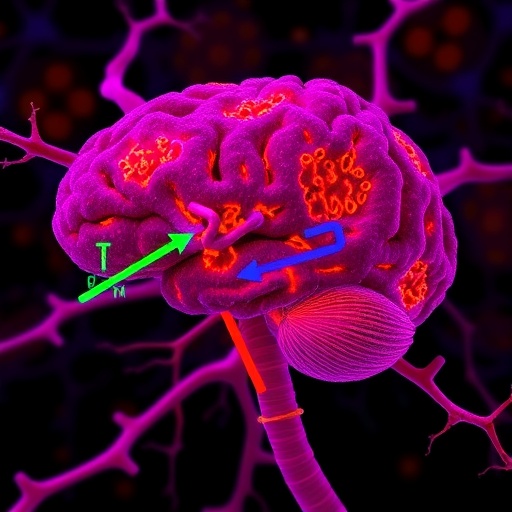In recent years, significant advances have been made in our understanding of neurodegenerative diseases, particularly Alzheimer’s disease. Researchers have consistently sought to unravel the complex biological mechanisms that underpin this devastating condition. In the forefront of these discoveries is a study conducted by Wang, Bu, Cao, and colleagues, which sheds light on the role of microRNAs in the modulation of inflammation within the brain, specifically in the context of Alzheimer’s disease.
The study centers around the microRNA known as Mir-199a-3p, identified as a crucial player in the inflammatory processes occurring in the brains of Alzheimer’s disease transgenic mouse models. MicroRNAs are small, non-coding RNA molecules that have been established as important regulators of gene expression. In this study, Mir-199a-3p is shown to play a significant role in promoting M1 polarization of microglia, which are the brain’s primary immune cells. This polarization is pivotal in understanding the neuroinflammatory response, as M1-polarized microglia are associated with pro-inflammatory cytokine production and detrimental effects on neuronal health.
Through a series of experiments, the researchers demonstrated that the upregulation of Mir-199a-3p in the transgenic mouse models led to enhanced M1 microglial activation. This activation not only increased the secretion of inflammatory cytokines but also exacerbated neuroinflammation, a key feature of Alzheimer’s pathology. Such neuroinflammation is believed to contribute to synaptic dysfunction and neurodegeneration, thus compounding the cognitive deficits observed in patients.
The methodology employed in the research was robust, employing both in vivo and in vitro approaches to validate the role of Mir-199a-3p. The transgenic mouse models, which closely mimic the genetic and phenotypic aspects of human Alzheimer’s disease, served as a valuable platform for assessing the impact of Mir-199a-3p on microglial function. Furthermore, primary microglial cultures allowed for the dissection of specific signaling pathways affected by Mir-199a-3p modulation.
Additionally, the study highlights the intricate relationship between inflammation and neurodegeneration, positing that targeting microRNAs like Mir-199a-3p could offer novel therapeutic avenues for treatment. The potential of microRNA-based therapies is particularly compelling, as they could provide a dual mechanism of action by both reducing neuroinflammation and safeguarding neuronal function. Such strategies could prove to be transformative in the management of Alzheimer’s disease, shifting the focus from symptomatic treatment to disease-modifying interventions.
The findings of Wang et al. also emphasize the broader implications of microRNA research in the field of neuroimmunology. Understanding how microRNAs can alter the immune response in the central nervous system could offer insights not only into Alzheimer’s disease but also into other neurodegenerative conditions. The dysregulation of microRNA pathways appears to serve as a common thread among various diseases characterized by neuroinflammation.
Moreover, the therapeutic targeting of Mir-199a-3p could involve the development of small-molecule inhibitors or the use of advanced gene-editing techniques to modulate its expression. These strategies may require careful consideration of delivery mechanisms to ensure effective targeting of the central nervous system, where blood-brain barrier penetration is often a significant challenge.
In conclusion, the research conducted by Wang and colleagues provides compelling evidence for the role of Mir-199a-3p in driving neuroinflammation through the promotion of M1 microglial polarization in Alzheimer’s disease models. This study enhances our understanding of the molecular underpinnings of inflammation in neurodegeneration and paves the way for innovative therapeutic strategies aimed at mitigating the impact of Alzheimer’s disease. As the scientific community continues to explore the nexus between inflammation and neurodegeneration, studies like this will serve as essential foundations for future research endeavors that aim to alleviate the burden of this devastating illness.
As we forge ahead in understanding the intricate landscape of neuroinflammation and its relationship to cognitive decline, it becomes increasingly evident that microRNAs represent a frontier in neurotherapeutics. By targeting specific pathways involved in microglial activation and inflammation, we may not only unlock new treatment modalities but also enhance our overall grasp of the pathophysiology of neurodegenerative diseases.
The journey toward effective therapies for Alzheimer’s disease remains challenging, yet hopeful. Each study adds a piece to the puzzle, driving scientific inquiry further into the biological mysteries that shroud neurodegenerative conditions. The future of neuropharmacology may well hinge on the insights gleaned from microRNA research, with the hope that a deeper understanding of these molecular players will lead to breakthroughs that can ultimately halt or reverse the ravages of Alzheimer’s disease.
In summary, the exploration of Mir-199a-3p as presented by Wang and colleagues is a significant step in elucidating the connection between microRNAs, neuroinflammation, and Alzheimer’s disease. As we continue to piece together the implications of these findings, the partnership between basic science and clinical application will be vital in translating this knowledge into tangible benefits for patients suffering from neurodegenerative disorders.
Subject of Research: The impact of Mir-199a-3p on neuroinflammation and microglial polarization in Alzheimer’s disease.
Article Title: Mir-199a-3p aggravates neuroinflammation in an Alzheimer’s disease transgenic mouse model by promoting M1-polarization microglia.
Article References:
Wang, C., Bu, X., Cao, M. et al. Mir-199a-3p aggravates neuroinflammation in an Alzheimer’s disease transgenic mouse model by promoting M1-polarization microglia.
BMC Neurosci 26, 45 (2025). https://doi.org/10.1186/s12868-025-00965-5
Image Credits: AI Generated
DOI: 10.1186/s12868-025-00965-5
Keywords: Alzheimer’s disease, neuroinflammation, microglia, Mir-199a-3p, M1 polarization, neurodegeneration, microRNAs, gene editing, neurotherapeutics.




